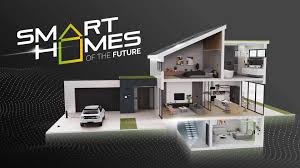Smart Homes of the Future: How Technology Is Making Our Lives Easier
The concept of a smart home has evolved significantly, transforming traditional living spaces into interconnected environments designed for comfort, efficiency, and security. With advancements in technology, smart homes of the future promise to make our lives easier, more convenient, and environmentally friendly. Here’s how:
1. Intelligent Automation
- Voice-Activated Systems: Devices like Amazon Alexa, Google Assistant, and Apple’s Siri allow homeowners to control lighting, appliances, and entertainment through simple voice commands.
- Predictive Automation: Smart homes can learn routines and preferences, adjusting lighting, heating, or cooling automatically based on time, weather, or occupancy.
Example: A smart thermostat like Nest adjusts the temperature based on your daily habits, saving energy and money.
2. Enhanced Security
- Smart Surveillance: Advanced cameras with AI-powered facial recognition and motion detection monitor homes in real-time and alert homeowners to potential threats.
- Remote Access: Homeowners can lock or unlock doors, view security footage, and monitor alarms remotely through smartphone apps.
- Emergency Integration: Smart systems can automatically contact emergency services during incidents like break-ins or fires.
Example: Ring’s video doorbells allow homeowners to see and speak to visitors from anywhere in the world.
3. Energy Efficiency
- Smart Appliances: Energy-efficient devices, such as smart refrigerators and washing machines, optimize their operations to reduce energy consumption.
- Solar Integration: Smart homes incorporate solar panels and energy storage systems that sync with household energy needs, reducing reliance on the grid.
- Energy Monitoring: Real-time insights into energy usage help homeowners identify ways to conserve energy and lower utility bills.
Example: Tesla Powerwall stores solar energy and provides backup power during outages.
4. Health and Wellness
- Air Quality Monitoring: Smart sensors monitor indoor air quality and adjust ventilation or notify homeowners of harmful pollutants.
- Health Tracking: Smart bathrooms equipped with health-monitoring systems can track vitals like blood pressure, heart rate, and hydration levels.
- Lighting for Well-Being: Circadian lighting systems adjust brightness and color to support natural sleep-wake cycles.
Example: Philips Hue smart lighting can simulate natural sunlight, promoting better mood and sleep.
5. Seamless Entertainment
- Integrated Systems: Smart home hubs connect all entertainment devices, allowing seamless control of TVs, speakers, and gaming consoles.
- Customized Experiences: AI curates personalized playlists, movie recommendations, and gaming settings based on user preferences.
- Multi-Room Sync: Music or video can play across multiple rooms, creating a cohesive entertainment experience.
Example: Sonos speakers offer multi-room audio control for a synchronized listening experience.
6. Smart Kitchens
- Connected Appliances: Smart ovens, refrigerators, and coffee makers can be controlled remotely or programmed to prepare meals at specific times.
- Recipe Assistance: AI-powered devices provide step-by-step cooking guidance, adjust cooking times, or recommend recipes based on available ingredients.
- Inventory Management: Smart fridges track expiration dates and create shopping lists automatically.
Example: Samsung’s Family Hub refrigerator provides a touchscreen interface to manage groceries and stream entertainment.
7. Improved Accessibility
- Voice-Controlled Systems: For individuals with disabilities, smart homes enable greater independence through voice-activated controls for doors, lights, and appliances.
- Adaptive Technologies: Sensors and AI adjust home settings automatically to accommodate mobility or sensory impairments.
- Emergency Features: Smart homes can detect falls or health emergencies and alert caregivers or medical professionals.
Example: Devices like Google Nest Hub Max allow hands-free control of smart home features.
8. Eco-Friendly Innovations
- Water Conservation: Smart irrigation systems monitor weather conditions and soil moisture to water gardens efficiently.
- Waste Reduction: AI in smart kitchens minimizes food waste by suggesting recipes for soon-to-expire items.
- Sustainable Materials: Future smart homes will integrate eco-friendly construction materials with built-in smart technologies.
Example: Rachio smart sprinkler systems optimize water usage for landscaping.
9. Future Technologies on the Horizon
- Holographic Interfaces: Home systems could feature holographic displays for immersive control of devices and entertainment.
- AI-Driven Personal Assistants: Advanced AI will anticipate needs and execute complex tasks without prompts.
- Connected Communities: Smart homes will link with neighborhood systems for shared energy, security, and resources.
Challenges and Considerations
- Privacy Concerns: As smart homes collect vast amounts of data, ensuring robust security and privacy measures is crucial.
- Compatibility: Integrating devices from different manufacturers requires standardization and interoperability.
- Cost: Initial investments in smart technology can be high, though they often pay off in savings and convenience over time.
Conclusion
Smart homes of the future are reshaping how we live, making our lives more convenient, secure, and sustainable. As technology continues to advance, the possibilities for innovation are limitless, creating living spaces that truly work for us.
Would you like advice on setting up a smart home or recommendations for specific devices?










Leave a Comment